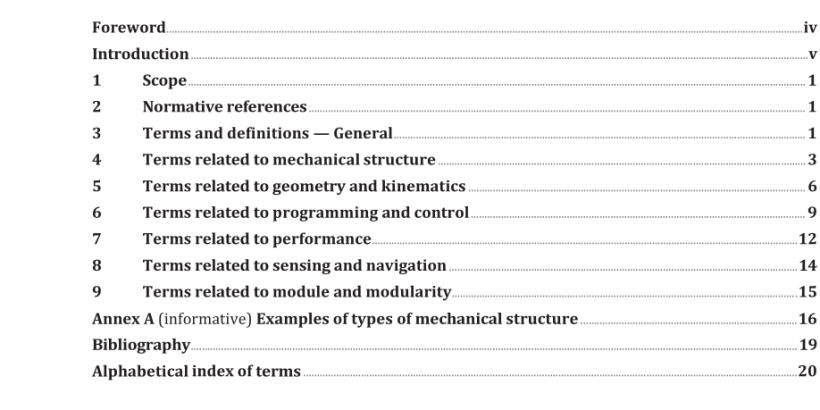ISO 8373:2021 pdf download – Robotics — Vocabulary.
3.6 industrial robot automatically controlled, reprogrammable multipurpose manipulator (4.14), programmable in three or more axes, which can be either fixed in place or fixed to a mobile platform (4.16) for use in automation applications in an industrial environment Note 1 to entry: The industrial robot includes: — — — the manipulator, including robot actuators (4.1) controlled by the robot controller; the robot controller; the means by which to teach and/or program the robot, including any communications interface (hardware and software). Note 2 to entry: Industrial robots include any auxiliary axes that are integrated into the kinematic solution. Note 3 to entry: Industrial robots include the manipulating portion(s) of mobile robots, where a mobile robot consists of a mobile platform with an integrated manipulator or robot. 3.7 service robot robot (3.1) in personal use or professional use that performs useful tasks for humans or equipment Note 1 to entry: Tasks in personal use include handling or serving of items, transportation, physical support, providing guidance or information, grooming, cooking and food handling, and cleaning. Note 2 to entry: Tasks in professional use include inspection, surveillance, handling of items, person transportation, providing guidance or information, cooking and food handling, and cleaning. 3.8 medical robot robot (3.1) intended to be used as medical electrical equipment or medical electrical systems Note 1 to entry: A medical robot is not regarded as an industrial robot ( 3.6 ) or a service robot (3.7 ).
3.14 robot cooperation information and action exchanges between multiple robots (3.1) to ensure that their motions work effectively together to accomplish the task 3.15 human–robot interaction HRI information and action exchanges between human and robot (3.1) to perform a task by means of a user interface (6.18) EXAMPLE Exchanges through vocal, visual and tactile means. Note 1 to entry: Because of possible confusion, it is advisable not to use the abbreviated term “HRI ” for human – robot interface when describing user interface. 3.16 validation confirmation by examination and provision of objective evidence that the particular requirements for a specific intended use have been fulfilled [SOURCE: ISO 9000:2015, 3.8.13, modified — definition modified and notes to entry removed.] 3.17 verification confirmation by examination and provision of objective evidence that the requirements have been fulfilled [SOURCE: ISO 9000:2015, 3.8.12, modified — definition modified and notes to entry removed.]
4.15.1 wheeled robot mobile robot (4.15) that travels using wheels Note 1 to entry: See Figure A.6 . 4.15.2 legged robot mobile robot (4.15) that travels using one or more legs (4.4) Note 1 to entry: See Figure A.7. 4.15.3 biped robot legged robot (4.15.2) that travels using two legs (4.4) Note 1 to entry: See Figure A.8 . 4.15.4 crawler robot tracked robot mobile robot (4.15) that travels on tracks Note 1 to entry: See Figure A.9. 4.15.5 humanoid robot robot (3.1) with body, head and limbs, looking and moving like a human Note 1 to entry: See Figure A.8 . 4.16 mobile platform assembly of the components which enables locomotion Note 1 to entry: A mobile platform can include a chassis which can be used to support a load ( 7.2). Note 2 to entry: A mobile platform can provide the structure by which to affix a manipulator (4.14). Note 3 to entry: Mobile platform following a predetermined path ( 5.5.4 ) indicated by markers or external guidance commands, typically used for logistic tasks in industrial automation is also referred to as Automated Guided Vehicle (AGV) or Driverless Industrial Truck. Standards for such vehicles are developed by ISO/TC 110. 4.17 wearable robot robot (3.1) that is attached to and carried by the human during use and provides an assistive force for supplementation or augmentation of personal capabilities
5.2 inverse kinematics mathematical determination of the joint values of a mechanical linkage, based on the relationship of the coordinate systems of two parts of this linkage Note 1 to entry: For a manipulator (4.14), it is usually the relationship between the tool coordinate system ( 5.11) and the base coordinate system ( 5.8 ) that is used to determine the joint values. 5.3 axis direction used to specify the robot (3.1) motion in a linear or rotary mode Note 1 to entry: “Axis ” is also used to mean “robot mechanical joint ”. 5.4 degree of freedom DOF one of the variables (maximum number of six) required to define the motion of a body in space Note 1 to entry: Because of possible confusion with axes ( 5.3 ), it is advisable not to use the term degree of freedom to describe the motion of the robot. 5.5 pose combination of position and orientation in space Note 1 to entry: Pose for the manipulator (4.14) normally refers to the position and orientation of the end-effector (4.12) or the mechanical interface (4.11). Note 2 to entry: Pose for a mobile robot (4.15) can include the set of poses of the mobile platform (4.16) and of any manipulator attached to the mobile platform, with respect to the mobile platform coordinate system (5.12).
